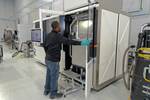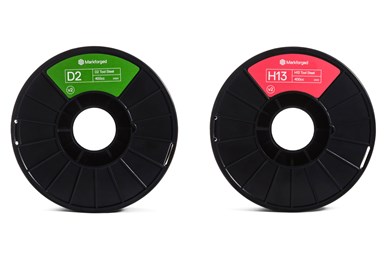3D Printing Tool Steels Reformulated for More Flexible, Less Brittle Filaments
Markforged has reformulated its H13 and D2 tool steel filaments for use with its Metal X 3D printing system.
Markforged’s newest versions of H13 tool steel and D2 tool steel filaments were developed to be used with its Metal X 3D fused filament fabrication (FFF) printing system and feature an updated binder that results in a significantly more flexible and less brittle filament. The additional materials are part of the company’s strategy to strengthen manufacturing resiliency by enabling industrial production at the point of need.
The new filaments are reformulations of Markforged’s most popular tool steels. The company says these materials improve quality of life and printer performance for its customers, while enabling future print modes that increase the breadth of applications the Metal X could support.
The updated H13 and D2 tool steel spools can be loaded in an unheated Metal X chamber, which reduces startup and material changeover time. The new spools also contain 400 cc of material, which is twice as much material than the older versions, enabling more printing to be done before needing to change spools.
The H13 tool steel is a versatile hot work tool steel for manufacturing operations. Harder than 17-4 PH stainless steel and capable of maintaining material properties at high temperatures, H13 tool steel is a versatile material with which to work. Markforged H13 can be heat treated to 45 HRC with a UTS of 1680 MPa, and is used by Markforged customers for tool bodies, brazing fixtures and other parts where hardness or heat resistance are required.
D2 tool steel is a cold work tool steel optimized for a variety of manufacturing applications. D2 are cold work tool steels defined by their extremely high hardness after heat treatment. D2 tool steel is harder and more wear-resistant than A2 tool steel, but less tough. It can be used for cutting and forming tools, or other applications where high hardness are valued.
Related Content
-
The Secrets to Hard Milling Success
The Secrets to Hard Milling Success
-
Solving Mold Alignment Problems with the Right Alignment Lock
Correct alignment lock selection can reduce maintenance costs and molding downtime, as well as increase part quality over the mold’s entire life.
-
Laser Welding Versus Micro Welding
The latest battle in finely detailed restoration/repair of mold materials.
















